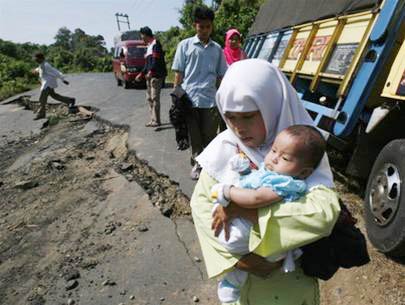Super seismic, super tsunami threaten Southeast Asia
Large earthquakes off the Sumatra islands, Indonesia on September 12, can lead to a massive earthquake that causes tsunamis, leading to the deaths of hundreds of thousands of people in the area.
The catastrophe from an earthquake is quite possible in the near future. And not only Indonesia but also Bangladesh and Myanmar are in danger.
From September 12, the Sumatra Islands were shaking violently by an earthquake measuring 8.4 on the Richter scale and 51 consecutive aftershocks, including two waves of up to 7.8 and 7.1 on the Richter scale. The Straits Times newspaper (Singapore) quoted the famous geologist Kerry Sieh, who said the seismic forces formed a " round of tension " around the Mentawai strip (archipelago Mentawai, west Sumatra). This is an area created by two Indo-tectonic plates - Australia and Sunda.

Serangai, Indonesia villagers are miserable when they flee because of bad roads due to earthquakes (Photo: TTO)
Super seismic
According to Professor Sieh, of the University of California Technology, if the area is unbearable, it will create a "super seismic" strong from 9-19 Richter levels. Accompanied by huge tsunamis hitting the province of Padang on the Sumatra Islands. "The current situation is like a train crash going on," Professor Sieh said. That terrible disaster can kill at least 100,000 people.
Professor Sieh also said that " super seismic " could happen in the period from now until three decades. However, geological developments off the recent island of Sumatra suggest that it will likely take place in the near future. The December 2004 earthquake and tsunami also came from the same mechanism when the Aceh-Andaman (Bengal Bay Andaman Islands) broke through pressure.
Every cloud has a silver lining
On September 14, the area off Sumatra island suffered another aftershock of 6.6 on the Richter scale, causing the Indonesian government to issue a new tsunami warning (the sixth time in the past three days).The Jakarta government has also announced a state of emergency for the cities of Bengkulu and Padang, which have suffered the most devastating earthquakes.
Reuters quoted experts as saying Indonesia had twice been fortunate in the last earthquake.Firstly, seismic waves created high tsunamis of over 3m.However, they did not hit the shore but rushed to the sea.The reason is broken seabed phenomenon - earthquake generation mechanism - this time there is a difference compared to the earthquake in December 2004.And the small tsunami hit Padang did not cause much damage.
Luckily, the second earthquake took place in the evening instead of at night like in December 2004.At that time, the Indonesian people ran straight to the road when the ground began to shake so the number of people killed was only 13.
Professor Sieh said in the Mentawai region, there was a "super seismic" every 200-230 years, and there were two such big earthquakes in 1797 and 1833. "We can measure The tension of this stratigraphic tectonic, therefore, can confirm that we are at a critical moment. "
It was Professor Sieh who predicted the success of the earthquake in the Nias-Simeulue range, which lies between the Mentawai and Aceh-Andaman bands three months after the 2004 earthquake and tsunami disaster. god in Sumatra, Professor Sieh and colleagues use the system to gather information from global positioning system and the monitoring process of coral systems in Sumatra.
Super tsunami
Meanwhile, the Australian Geoscience Agency's study warns that a strong earthquake of 8.5-9 Richter is likely to occur in areas off Myanmar and Bangladesh within the next few decades or so. than. Meanwhile, a high-meter tsunami from the Bay of Bengal off the Indian Ocean will strike Bangladesh and the west coast of Myanmar.
"The number of people killed can be more than 1 million," AP News quoted Professor Phil Cummins, the study author. The reason is that the affected area is very close to the second most populous city of Chittagong in Bangladesh, while there are tens of millions of others living in areas of sea level in the region.
However, Professor Cummins admits it will be difficult to convince the Bangladesh and Myanmar authorities to take measures to prepare for the disaster, because this is not a immediate threat. Many geological experts like Professor Sieh support the Australian Geological Survey study. However, other experts suggest that the tsunami possibility in the Bay of Bengal is possible, but the worst-affected country will be Sri Lanka and not Myanmar and Bangladesh.
HIEU TRUNG
- The truth about the risk of super-earthquakes in Asia
- Floods, droughts will attack Southeast Asia more rapidly
- Thailand exercises against tsunami
- Southeast Asia is in danger of becoming a world outbreak
- Southeast Asia has a high rate of arsenic poisoning in the country
- The worst natural disaster is still ahead
- Extend the tsunami warning system function
- Typhoon attacks on Southeast Asia are getting stronger
- The cause of tsunami appeared after the earthquake
- Southeast Asia is vulnerable to hackers
- Use an early warning tsunami radar
- Southeast Asia should learn Chinese technology strategy
 Is the magnetic North Pole shift dangerous to humanity?
Is the magnetic North Pole shift dangerous to humanity? Washington legalizes the recycling of human bodies into fertilizer
Washington legalizes the recycling of human bodies into fertilizer Lightning stone - the mysterious guest
Lightning stone - the mysterious guest Stunned by the mysterious sunset, strange appearance
Stunned by the mysterious sunset, strange appearance